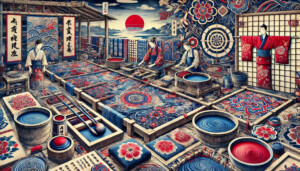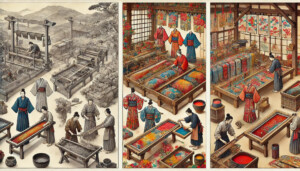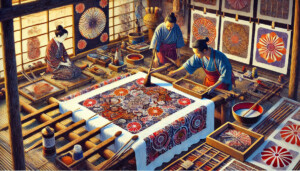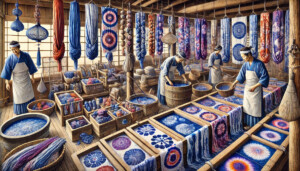Introduction: The Timeless Beauty of Japanese Textile Dyeing
Japanese textile dyeing is more than just a method of coloring fabric; it is an art form that embodies the essence of Japanese culture. This ancient craft has been meticulously preserved and passed down through generations, with each technique telling its own story of Japan’s rich heritage. From the vibrant hues of natural dyes to the intricate patterns created through labor-intensive processes, Japanese textile dyeing represents a perfect blend of artistry, tradition, and cultural symbolism. This article delves into the fascinating world of Japanese textile dyeing, exploring its history, techniques, and enduring cultural significance.
Historical Evolution of Japanese Textile Dyeing
The history of Japanese textile dyeing dates back to ancient times, with the earliest techniques being introduced from China and Korea. Over the centuries, these methods were adapted and refined, resulting in unique Japanese styles that are revered worldwide today.
- Asuka and Nara Periods (538-794 AD): During these periods, the influence of Chinese culture was profound, leading to the introduction of early dyeing techniques such as silk dyeing. The use of imported dyes and advanced weaving techniques set the foundation for the development of Japanese textile arts.
- Heian Period (794-1185 AD): The Heian period marked the beginning of Japan’s cultural renaissance. During this time, dyeing techniques such as Shibori (tie-dyeing) began to emerge. The courtly aristocracy’s demand for luxurious and ornate textiles spurred the creation of elaborate patterns and designs, leading to the development of unique Japanese dyeing methods.
- Muromachi and Edo Periods (1336-1868 AD): The Muromachi period saw the rise of Katazome (stencil dyeing) and Yuzen (hand-painted dyeing), techniques that flourished during the Edo period. The Edo period, in particular, was a time of economic and cultural growth, allowing the dyeing industry to thrive. Artisans perfected their craft, creating textiles that were not only functional but also artistic masterpieces. The restrictions on wearing luxurious fabrics imposed by the Tokugawa shogunate led to the development of more subdued yet intricately patterned textiles, which became symbols of status and taste.
Traditional Dyeing Techniques
Japanese textile dyeing is characterized by a variety of techniques, each with its own distinct style and process. These methods have been meticulously refined over centuries and are still practiced by artisans today.
- Katazome (Stencil Dyeing):
Katazome is a traditional Japanese dyeing technique that involves the use of stencils to create intricate patterns on fabric. The process begins with the preparation of the fabric, usually silk or cotton, which is then stretched on a frame. A resist paste made from rice flour and bran is applied to the fabric using stencils carved from paper. Once the resist is dry, the fabric is dyed, with the resist preventing the dye from penetrating the areas it covers. After dyeing, the resist is washed away, revealing the pattern. Katazome is known for its precision and the ability to create detailed, repeating patterns. The technique has been used to produce kimono, obi, and other traditional garments, as well as textiles for home decor.
- Shibori (Tie-Dyeing):
Shibori is perhaps the most well-known of all Japanese dyeing techniques. The term “shibori” refers to a variety of resist-dyeing methods that involve folding, twisting, or bunching the fabric before dyeing to create patterns. There are several types of shibori, each producing a distinct effect:
- Kanoko Shibori: The fabric is tightly bound with thread in small sections, creating circular patterns resembling dots.
- Arashi Shibori: The fabric is wrapped around a pole and then tightly bound with thread. The pole is then twisted, and the fabric is dyed, resulting in diagonal, linear patterns that resemble rain.
- Itajime Shibori: The fabric is folded and sandwiched between two pieces of wood or other flat objects before dyeing. This creates geometric patterns, often squares or triangles.
Shibori’s versatility and the spontaneity of its patterns have made it a popular technique for both traditional and contemporary textiles.
- Yuzen (Hand-Painted Dyeing):
Yuzen dyeing is a highly detailed hand-painting technique that originated in Kyoto during the Edo period. The process involves drawing intricate designs directly onto fabric using a special rice paste resist. After the design is outlined, the artisan carefully applies color using a fine brush. The colors are often blended on the fabric to create subtle gradations and shading. Once the dyeing is complete, the fabric is steamed to set the colors, and the resist is removed, leaving the intricate design behind. Yuzen dyeing is known for its delicate, painterly quality and is often used for kimono and obi, with motifs that include flowers, birds, and landscapes.
- Kasuri (Ikat Weaving):
Kasuri, also known as ikat, is a weaving technique that involves resist dyeing the threads before weaving them into fabric. The threads are bound at intervals to prevent dye from penetrating certain areas, creating patterns once the threads are woven. The resulting fabric has a slightly blurred, painterly effect, characteristic of kasuri textiles. This technique is used to create intricate designs on both the warp and weft threads, leading to a complex interplay of patterns. Kasuri is often used for kimono, especially in regions like Kurume and Tokushima, where the technique is a regional specialty.
Natural Dyes: The Colors of Nature
One of the most distinctive features of traditional Japanese textile dyeing is the use of natural dyes, which are derived from plants, minerals, and even insects. These dyes produce rich, vibrant colors that are imbued with cultural significance.
- Indigo (Ai): Indigo dyeing has a long history in Japan and is perhaps the most iconic of all Japanese dyes. The deep blue color, known as “Japan blue,” is achieved through repeated immersion of the fabric in a fermented indigo vat. Indigo dyeing was widely practiced in rural areas, where the indigo plant was cultivated. The color blue was associated with the common people during the Edo period, as it was prohibited for the lower classes to wear brightly colored clothing. Today, indigo remains a popular dye, used in everything from traditional textiles to modern fashion.
- Safflower (Benibana): Safflower dye produces a bright red color, known as “beni,” which was highly prized in Japan. The dye is extracted from the petals of the safflower plant, and the process is labor-intensive, requiring a large amount of petals to produce a small quantity of dye. Beni was often used to dye silk, creating luxurious textiles for the aristocracy. The color red was associated with life and vitality, and it was often used in garments for special occasions.
- Persimmon (Kakishibu): Persimmon dye is made from the fermented juice of unripe persimmons and produces a rich brown color. Kakishibu has been used for centuries to dye textiles, as well as to waterproof and strengthen paper and wood. The dye has antibacterial properties and was traditionally used to dye work clothes and fishing nets. The warm, earthy tones of persimmon-dyed textiles have made a resurgence in recent years, appreciated for their natural beauty and environmental sustainability.
Cultural Significance of Textile Dyeing
Textile dyeing in Japan is deeply intertwined with cultural practices and regional identities. Different dyeing techniques are often associated with specific regions, each with its own traditions and styles.
- Katazome in Kyoto: Kyoto has long been the center of textile production in Japan, and katazome is one of its most famous dyeing techniques. The intricate patterns created through katazome were highly sought after by the aristocracy and were used to create exquisite kimono and obi. The patterns often feature motifs from nature, such as flowers, birds, and landscapes, reflecting the deep connection between Japanese culture and the natural world.
- Shibori in Arimatsu: The town of Arimatsu in Aichi Prefecture is renowned for its shibori textiles. Shibori has been practiced in Arimatsu for over 400 years, and the town remains a hub for this traditional craft. The unique patterns created through shibori have made Arimatsu textiles highly prized, and the town hosts an annual shibori festival that attracts visitors from around the world.
- Yuzen in Kanazawa: Kanazawa, in Ishikawa Prefecture, is known for its yuzen dyeing. The delicate, hand-painted designs of Kanazawa yuzen often feature intricate floral motifs and scenes from nature. The region’s artisans have preserved this traditional technique, and Kanazawa yuzen remains a symbol of elegance and sophistication.
Contemporary Adaptations of Japanese Textile Dyeing
While traditional dyeing techniques have been preserved, they have also been adapted to meet modern needs and tastes. Contemporary Japanese artists and designers have embraced these ancient methods, incorporating them into modern fashion and design.
- Revival of Natural Dyeing: As consumers become more environmentally conscious, there has been a resurgence of interest in natural dyes. Japanese artisans are reviving ancient dyeing techniques, using natural materials to create textiles that are both beautiful and sustainable. This revival has led to a renewed appreciation for the craftsmanship and environmental benefits of traditional dyeing methods.
- Fusion with Modern Fashion: Japanese designers are incorporating traditional dyeing techniques into contemporary fashion, creating garments that are both modern and rooted in tradition. Designers like Issey Miyake and Yohji Yamamoto have experimented with shibori and indigo dyeing, bringing these ancient techniques to the international fashion stage.
- Textile Dyeing in Art and Design: Beyond fashion, Japanese textile dyeing has found its place in the world of contemporary art and design. Artists are using traditional dyeing methods to create works that challenge the boundaries of art and craft, exploring new forms and materials while staying true to the essence of Japanese textile traditions.
Learning Japanese Textile Dyeing: A Beginner’s Guide
For those interested in learning about Japanese textile dyeing, there are many resources available, both in Japan and internationally. Here are some steps to get started:
- Understand the Basics: Begin by familiarizing yourself with the different dyeing techniques, such as shibori, katazome, and yuzen. Understanding the history and cultural significance of these methods will deepen your appreciation for the craft.
- Take a Workshop: Many artisans and cultural centers offer workshops on Japanese textile dyeing. These hands-on experiences allow you to learn the techniques from skilled practitioners and gain a deeper understanding of the craft.
- Practice at Home: For those unable to attend workshops, there are numerous online resources and kits available for practicing Japanese dyeing techniques at home. Start with simple projects, such as shibori-dyed scarves, and gradually work your way up to more complex techniques.
- Explore Regional Specialties: If you have the opportunity to travel to Japan, visit regions known for their textile dyeing traditions, such as Kyoto, Arimatsu, and Kanazawa. These areas often have museums, workshops, and shops dedicated to their local crafts, offering a deeper insight into the world of Japanese textiles.
- Join a Community: Connect with other enthusiasts and artisans who share your interest in Japanese textile dyeing. Online forums, social media groups, and local craft societies can provide support, inspiration, and opportunities for collaboration.
Cultural Significance and Global Influence
Japanese textile dyeing has not only played a vital role in Japan’s cultural history but has also influenced global textile traditions and contemporary design. The techniques developed in Japan have been adapted and embraced by artisans and designers around the world.
- International Influence: Japanese textile dyeing techniques, particularly shibori and indigo dyeing, have inspired textile artists globally. These methods have been integrated into various cultural contexts, leading to a fusion of styles that enriches the global textile landscape.
- Exhibitions and Collaborations: Japanese textile dyeing has been showcased in international exhibitions, highlighting the artistry and craftsmanship involved. Collaborations between Japanese artisans and global designers have brought these traditional techniques to new audiences, preserving the craft while pushing its boundaries.
- Cultural Preservation: The preservation of Japanese textile dyeing techniques is not only important for Japan but also for the global community. As interest in sustainable and ethical fashion grows, the methods and values embodied in Japanese textile dyeing offer valuable lessons for contemporary design and production.
Conclusion: Preserving the Art of Japanese Textile Dyeing
Japanese textile dyeing is a testament to the enduring beauty and cultural significance of traditional crafts. As we move into an era of rapid technological advancement and globalized culture, it is crucial to preserve these ancient techniques while embracing their modern adaptations. By understanding the history, techniques, and cultural importance of Japanese textile dyeing, we can ensure that this art form continues to thrive, inspiring future generations and contributing to a sustainable and culturally rich world.






Comment